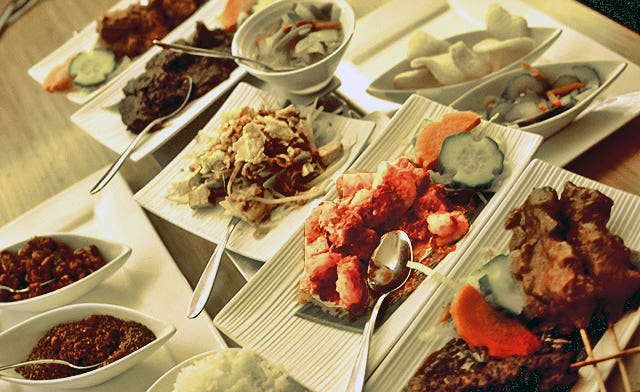
Rijstaffel: Amsterdam’s Indonesian Feast
For all its rich history, beautiful cities, and exquisite drinking culture, it's rare that people travel to the Netherlands specifically for the food. While it's true that Dutch cuisine has come a long way from potatoes and porridge, "Holland" and "feats of gastronomic derring-do" don't typically go hand-in-hand. Which is why the popularity of rijsttafel, a complex and intriguing Indonesian feast, in the country's capital city of Amsterdam came to me as such an unexpected pleasure.
History buffs, of course, won't be surprised by the number of Indonesian restaurants (or "Indies," as the locals call them) tucked along Amsterdam's famed canals and cobblestone streets: for over 300 years, Indonesia was a Dutch colony, only gaining its independence in the relatively recent year of 1942. The lush Southeast Asian archipelago — in particular, the mountainous Maluku islands, better known as the Spice Islands — supplied most of the world with nutmeg, mace, clove and black pepper during the 17th and 18th centuries, thanks in large part to the Dutch East India Company. Over the course of 200 years, the Company sent over a million Europeans to work on Asian trade routes, at a time when the demand for spices was at an all-time high.
It didn't take long for Dutch colonials to become smitten with Indonesia's palate-boggling array of foods: vegetables quick-pickled with vinegar and sugar (acar timun), caramelized beef in a heady coconut sauce (rendang), sticky-sweet fried bananas (pisang goring), or spicy curried collards (gulai sayur). But since Indonesian cuisine varies so wildly across the country's 17,000 islands, high-ranking Dutch officials developed their own greatest-hits version of an Indonesian feast, their servants delivering dozens of miniature portions of regional foods, from the coconut beef sate of eastern Java (served with a spicy peanut sauce) to the spice-stuffed duck of Bali, all laid out around mountainous platters of rice. The Dutch called this marathon meal rijsttafel, or "rice table."
"It's not a random mish-mash—it's more of an orchestration of dishes," explains author and Dutch culinary historian Peter Rose. "Think of rijsttafel as a favorable way of combining flavors from different regions. The goal is to create an interesting combination of tastes and spices: hot, cold, sweet, salty, sour, bitter. There's a whole palate of flavors in one meal." And to an eighteenth-century northern European hailing from a damp, cold climate—with a cuisine to match—rijsttafel functioned as a most fantastic sensory overload.
While the Dutch relationship with Indonesia stretches back hundreds of years, the rise of rijsttafel as a popular food back in Europe didn't come until after World War II, when Indonesian immigrants streamed to the Netherlands after Indonesia declared its independence from Dutch rule. Many immigrants opened restaurants, and despite the fact that rijsttafel isn't strictly authentic Indonesian cuisine (both populations tend to agree that it's Dutch-Indonesian, a hybrid drawing on the palates of both cultures), they knew there was a market for this fanciful meal in their new home. And so, for the second time, Dutch residents embraced the far-flung islands' lush and vibrant cuisine—this time in their home country.
Today, rijsttafel abounds in Amsterdam's Indonesian restaurants. Reliable spots like Sama Sebo and Tempo Deoloe have been serving traditional rice tables for decades, while newcomers like Blue Pepper offer more contemporary versions, with individual portions instead of family-style feasts. It's a common meal out, popular with tourists and locals alike.
In its 60-year tenure in The Netherlands, rijsttafel has grown to occupy a unique space: it's an almost comically broad sampler of Indonesia's vast cuisine, distilled to Dutch specifications, then championed by Indonesians in their adopted homeland and duly welcomed by the locals. "It has become so much a part of who the Dutch are, because of our heritage and history," says Rose. "It's deeply interesting food."
Sama Sebo
P.C. Hooftstraat 27
1071 BL Amsterdam, Netherlands
tel: 020 662 8146
Utrechtsestraat 75
1017 VJ Amsterdam, Netherlands
tel: 020 625 6718
Blue Pepper
Nassaukade 366
1054 AB Amsterdam, Netherlands
020 489 7039
Keep Reading
Continue to Next Story










